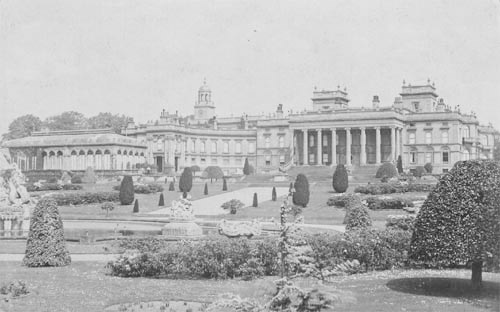Witley Court
Worcestershire
| Location | Great Witley | ||
| Year demolished | 1945 | ||
| Reason | Insufficient wealth - then fire | ||
| See all images: | Gallery | ||
| << Back to the main list |
Describing Witley Court as 'demolished' is misleading—today, under the care of English Heritage, its striking shell stands as one of the most impressive ruins in the country. Visiting today truly gives a sense of the scale and former splendour of one of England's most magnificent country houses.
 Witley Court was the result of several phases of construction spread over almost 400 years. Originally a large Jacobean house, it was bought by the Foley family in 1655 who were to own Witley Court for over 180 years. Over successive generations the house grew into a great mansion with extensive landscaped parkland. By the 1750s the house had been extended and redesigned in a Georgian style. In the early 19th century, the renowned architect John Nash was commissioned to further remodel the house, adding colonnades between the towers and enhancing the South Front. However, the seventh Baron Foley was an obese gambler who wrecked the family fortune, necessitating the sale of the estate in 1837.
Witley Court was the result of several phases of construction spread over almost 400 years. Originally a large Jacobean house, it was bought by the Foley family in 1655 who were to own Witley Court for over 180 years. Over successive generations the house grew into a great mansion with extensive landscaped parkland. By the 1750s the house had been extended and redesigned in a Georgian style. In the early 19th century, the renowned architect John Nash was commissioned to further remodel the house, adding colonnades between the towers and enhancing the South Front. However, the seventh Baron Foley was an obese gambler who wrecked the family fortune, necessitating the sale of the estate in 1837.
Aerial video tour of the ruins today (© Mat Stainton)
Full screen
The house was sold for £890,000 (equivalent to over £50 million today) to the Dudley family whose Black Country interests, which included ironworks, coal mines and quarries, provided a vast wealth. This immense wealth transformed Witley Court from a grand country house into one of the largest private palaces in Europe - a byword for luxury and elegance and visited by royalty. In 1846 Lord Ward started to improve the house and gardens. He asked the leading garden designer of the day, William Nesfield, who created parterres and monumental fountains, the largest of which - Perseus and Andromeda - could shoot water over 100ft into the air from a central sculpture which weighed more than 20 tons. For the house he engaged Samuel Daukes who created its Italianate look, extending the house further and creating the impressive Orangery which was linked to the South Portico by way of graceful curved wing.
However, by the 20th century, overseas competition had diminished the Dudley fortune and could no longer support such splendour and the house was mothballed and sold in 1920 to a local businessman, Sir Herbert Smith. A devastating fire in 1937 sealed its fate as a residence, as the insurance payout fell far short of covering the immense cost of repairs. The fire destroyed most of the rooms in the central and eastern sections, although much of the building was untouched by the fire. However the house and estate were auctioned off in 1938 and the house passed through a succession of owners who stripped what they could with vandalism destroying the little that remained. The house was saved from total destruction when the Department of the Environment took the building into its care in 1972 before it was eventually transferred to English Heritage. The house and grounds are now open to the public with visitors able to walk round the shell of the house where royalty also once strolled.
Further information about the gardens: English Heritage: Witley Court
The Church
The Church at Witley Court is notable not only for surviving the 1937 fire but also for its connection to another legendary lost house - Canons. Canons, the lavish estate of James Brydges, 1st Duke of Chandos, was renowned for its opulence before its demolition in the 1740s, making the Witley Church interior a rare surviving fragment.
The Church is widely regarded as one of Britain's finest Baroque churches. Built by the Foleys in 1733-5, replacing an existing medieval structure, the interior was transformed in 1747 when Lord Foley bought most of the internal decoration from the chapel at Canons, Lord Chandos' lavish palace built in Edgware, north London. Lord Foley employed the church's original architect James Gibbs to incorporate it - a wise choice as Gibbs had also designed the chapel at Canons. The items included ten sumptuous stained glass windows and ceiling paintings by Antonio Belluci. Lord Foley even had the plasterwork from Canons recreated to complete the transformation.
The church is open to visitors.